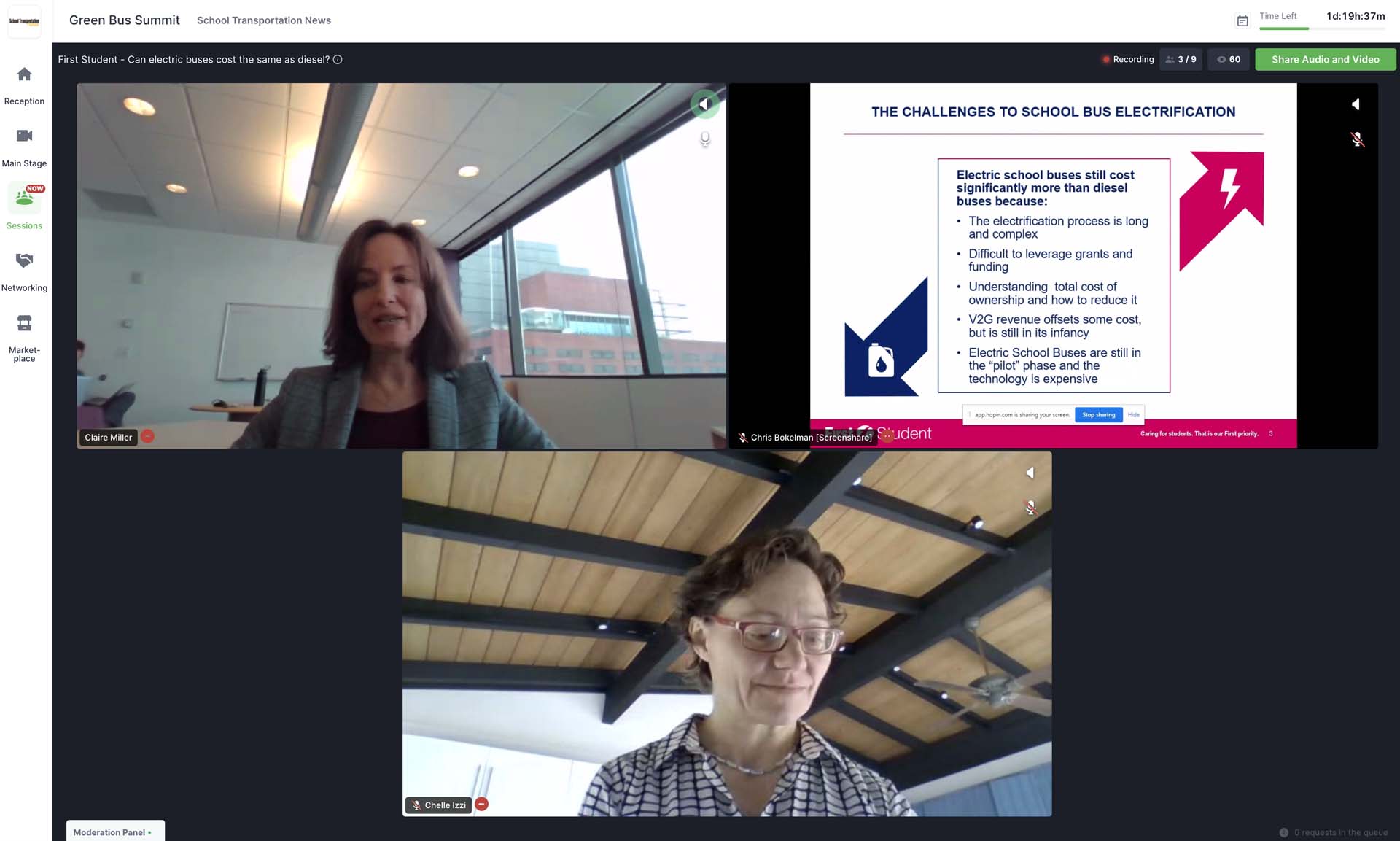With plans to electrify its national fleet of 43,000 yellow school buses, contractor First Student pulled back the curtain on its partnership with NextEra Energy Resources to share how it proposes to achieve this feat.
The partnership between First Student, the world’s largest school transportation provider, and NextEra, the world’s largest wind and solar power generator, was discussed during the recent Green Bus Summit.
Claire Miller, First Student’s senior vice president of strategy, business development, marketing and communications, shared the challenges of the “multifaceted and complex” electrification process. For example, EV tech is currently expensive and experimental. Additionally, leveraging grants and managing the total cost of ownership can be difficult.
Needing a knowledgeable partner with experience in renewable energy generation and infrastructure, First Student identified NextEra as the best partner to simplify the roadmap, constantly monitor funding sources, maximize savings, implement a support system, and leverage scale to bring down EV fleet operation costs.

Miller also spoke about the incentives for fleet electrification, such as state and federal grant sources.
“There is a lot of funding out there,” she stated.
Another goal is reducing maintenance costs, which will already be lower since there are fewer moving parts in an electric bus than in an internal combustion engine.
Chelle Izzi, executive director of distributed generation at NextEra, provided some financial tips to reduce surprises in a district or bus operation’s electric bill. She said that this requires a district to look “holistically” across its bus fleet and building operations, thus managing its operations and energy usage in tandem.
Understanding operational specifics as First Student does is key, she said. She noted route planning should be a big part of the conversation when considering the range of an electric bus.
One important point is that the energy for a pilot project is different than what is required for full fleet usage. Plan for the long-term electrification of your fleet, Izzi stressed.
“Make sure these are resilient systems, not just low-cost ones,” she said.
Miller and Kent Kuran, NextEra’s director of mobility solutions, spoke the following day on technical considerations for fleet electrification.
- Power
Kuran noted that running electric school buses does require substantial energy, often necessitating transformer upgrades or extra distribution lines. He added that districts must plan ahead to make sure the local utility is able to fully work with the fleet, and to ensure the bus operation is not overcharged for its electricity.
- Total Cost of Ownership
Miller stated that the startup cost for an EV fleet is more than diesel, plus bus operations have infrastructure to consider. Costs vary by school bus manufacturer, district location and operational needs. This makes it vital that transportation directors understand their total cost of ownership.
- Battery Strategy & Replacement
The battery can represent 30 to 50 percent of the total EV bus cost, Miller pointed out. She advised districts to consider battery capacity, size, warranty, degradation, leasing, and replacement. Being a relatively new and still experimental technology, batteries are currently estimated to have an estimated life of 6 to 10 years. Some can be reused.
It’s hard to understand the battery market, Kuran said, which is where organizations like NextEra can help.
- Maintenance
Electric school buses have fewer moving parts, so maintenance costs are less. But technicians who work on these systems need additional advanced training. Miller noted that there are extra safety considerations when working on electric buses, but technicians who are trained to do so are often paid more than diesel bus technicians.
- Route Optimization
A bus operation must consider its location and routine operations when choosing its battery size and electric bus specifications because longer routes need bigger batteries, Miller noted. First Student’s routing team is available to help on a consultant basis, she added.
- Infrastructure
Infrastructure costs are substantial and charger selection is important, Kuran shared. Controlling charging is important, too. For example, charging when a bus returns to the yard at the end of an afternoon run is unadvisable because that is peak charge time.
Izzi advised minimizing electric costs by using smart controls to manage when and how fast buses charge. Managing EV infrastructure could also involve solar energy or integrating with school buildings. Vehicle-to-grid (V2G) is a good way to help maximize revenue by reducing electric usage when prices are high and selling energy back to the grid for extra revenue.
Related: School Districts Expand Electric Bus Adoption for a Greener, Safer Future
Related: First Student Executive Miller Outlines School Bus Electrification Roadmap
Related: (Special Report) Selecting the Fuel that Makes Cents for You: Electric
Related: NYC Aims for Fleet of All-Electric School Buses by 2035
Related: Webinar Shares Incentives to Drive Adoption of Electric School Buses
Related: Infrastructure, Revenue Generation Available to Support EV Implementation
Kuran advised consideration of how resilient the grid is. In areas prone to hurricanes or tornados, backups may be needed.
- Partnership
Miller expressed optimism for the First Student and NextEra partnership, citing it as an essential part of starting up and running an EV fleet. Together they are innovating and adapting for cleaner school bus rides for students.














